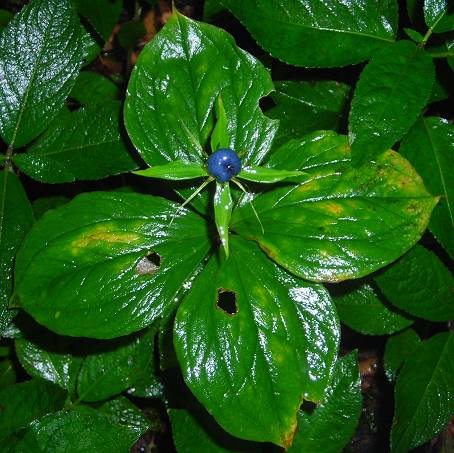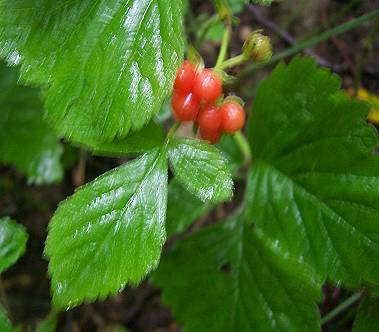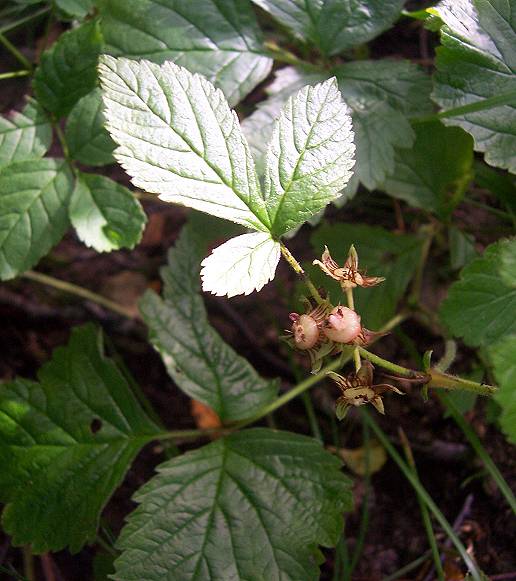
Herb Paris (Paris quadrifolia) berry
Back to the Trip index and Ryenats home pages
This was a YNU VC62 meeting. Unfortunately the weather was unkind, with heavy cloud at the start of the day which thickened to give us cold rain (and abysmal light, which is why there are so few pictures....). We met at the village hall at the bottom of Hawnby village where we were given maps and guidance on where we could explore – we had been granted access to the privately owned Hawnby Estate, an area extending from Arden Hall to Murton Bank, taking in Coomb Hill, Sunny Bank and Dale Town, Gowerdale, Noddle End and Peak Scar.

Herb Paris (Paris quadrifolia) berry
A small group of keen botanists set off on a loop past the church then headed west to Spring Wood, returning via Gowerdale and Dale End and the footpath to the bottom of Murton Bank and then back down to the village, where we joined the others for a very welcome cup of tea in the hall and the more formal part of the meeting.
The area around Hawnby is an interesting mixture of deep valleys, mixed woodland and pasture, with springs giving rise to small becks running down to the young Rye. Some of the valley slopes are rocky, with outcrops of both sandy beds and limestones. Despite the weather we had an interesting day, finding many plants (see partial list below).
 The star as far as I was concerned was stone bramble (Rubus saxatilis) in fruit, in Spring Wood (right: I have included the picture even though it’s blurred as the plant is so special). [See below for a picture of the same plant taken 23rd August in better weather, but after the berries had been eaten / fallen off.] I had previously seen it in flower on the roadside at Murton Bank within a mile or so, but never the red fruits. We found at least five plants with ripe fruit. In the same part of the wood was a colony of a dozen or so plants of Herb Paris (Paris quadrifolia), also in fruit. I was a little disappointed not to find Baneberry (Actaea spicata) here too.
The star as far as I was concerned was stone bramble (Rubus saxatilis) in fruit, in Spring Wood (right: I have included the picture even though it’s blurred as the plant is so special). [See below for a picture of the same plant taken 23rd August in better weather, but after the berries had been eaten / fallen off.] I had previously seen it in flower on the roadside at Murton Bank within a mile or so, but never the red fruits. We found at least five plants with ripe fruit. In the same part of the wood was a colony of a dozen or so plants of Herb Paris (Paris quadrifolia), also in fruit. I was a little disappointed not to find Baneberry (Actaea spicata) here too.
Emerging from the wood we found species such as Quaking Grass (Briza media), Burnet Saxifrage (Pimpinella saxifraga) and Small Scabious (Scabiosa columbaria) – all lime-lovers. As we climbed up towards Noddle End we found a wonderful limestone bank with marjoram, wild thyme, musk thistle, hawkbits and a tall hawkweed – to be identified later! There were also two plants of the extraordinary Great Mullein (Verbascum thapsus), although no rockrose or carline thistle, both of which might have been expected in such a habitat. On the footpath down to the foot of Murton Bank we passed through damp grassland with meadowsweet and a little Marsh Ragwort (Senecio aquaticus), a rather more attractive plant than its common relative which was also present; worryingly I did not see a single cinnabar moth caterpillar on this – normally it would have been covered in these black-and-orange larvae.
As we returned into the village we noticed a spread of a pink bindweed, which turned out to be Calystegia pulchra, a plant new to me. I was also pleased to see that most of the white bindweed was the native C. sepium not the invasive C. sylvatica.
This is not a complete list, I only noted the “interesting” species!Plant list
|
 Stone bramble (Rubus saxatilis) |
© Gill Smith August 2008. Pictures © Gill Smith & Jane Smyth 2008
Back to the Top, Trip index and Ryenats home pages